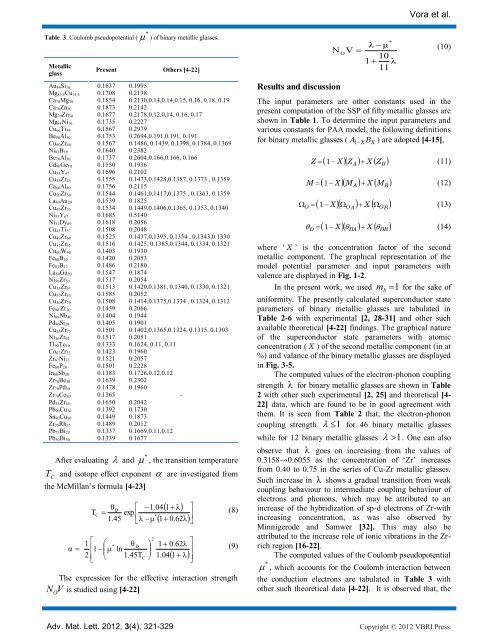Superconducting state parameters of binary metallic glasses
Superconducting state parameters of binary metallic glasses
Superconducting state parameters of binary metallic glasses
You also want an ePaper? Increase the reach of your titles
YUMPU automatically turns print PDFs into web optimized ePapers that Google loves.
*<br />
Table 3. Coulomb pseudopotential ( ) <strong>of</strong> <strong>binary</strong> <strong>metallic</strong> <strong>glasses</strong>.<br />
Metallic<br />
glass<br />
Present Others [4-22]<br />
Au84Si16 0.1637 0.1995<br />
Mg85.5Cu14.5 0.1708 0.2138<br />
Ca70Mg30 0.1854 0.2130,0.14,0.14,0.15, 0.16, 0.18, 0.19<br />
Ca70Zn30 0.1873 0.2142<br />
Mg70Zn30 0.1677 0.2178,0.12,0.14, 0.16, 0.17<br />
Mg84Ni16 0.1735 0.2227<br />
Cu66Ti34 0.1567 0.2979<br />
Be90Al10 0.1753 0.2694,0.191,0.191, 0.191<br />
Cu60Zr40 0.1567 0.1486, 0.1439, 0.1398, 0.1384, 0.1369<br />
Ni81B19 0.1640 0.2382<br />
Be70Al30 0.1737 0.2604,0.166,0.166, 0.166<br />
Cd90Ge10 0.1550 0.1936<br />
Cu33Y67 0.1696 0.2102<br />
Cu55Zr45 0.1555 0.1473,0.1428,0.1387, 0.1373 , 0.1359<br />
Ca60Al40 0.1756 0.2115<br />
Cu50Zr50 0.1544 0.1461,0.1417,0.1375 , 0.1363, 0.1359<br />
La80Au20 0.1539 0.1825<br />
Cu45Zr55 0.1534 0.1449,0.1406,0.1365, 0.1353, 0.1340<br />
Ni33Y67 0.1685 0.5140<br />
Ni31Dy69 0.1618 0.2056<br />
Cu43Ti57 0.1508 0.2048<br />
Cu40Zr60 0.1525 0.1437,0.1395, 0.1354 , 0.1343,0.1330<br />
Cu35Zr65 0.1516 0.1425, 0.1385,0.1344, 0.1334, 0.1321<br />
Cu60W40 0.1403 0.1930<br />
Fe80B20 0.1420 0.2053<br />
Fe83B17 0.1486 0.2180<br />
La80Ga20 0.1547 0.1874<br />
Ni50Zr50 0.1517 0.2054<br />
Cu33Zr67 0.1513 0.1420,0.1381, 0.1340, 0.1330, 0.1321<br />
Cu57Zr43 0.1585 0.2052<br />
Cu30Zr70 0.1508 0.1414,0.1375,0.1334 , 0.1324, 0.1312<br />
Fe90 Zr10 0.1459 0.2066<br />
Ni60Nb40 0.1404 0.1944<br />
Pd80Si20 0.1405 0.1901<br />
Cu25Zr75 0.1501 0.1402,0.1365,0.1324, 0.1315, 0.1303<br />
Ni36Zr64 0.1517 0.2051<br />
Tl90Te10 0.1333 0.1624, 0.11, 0.11<br />
Co67Zr33 0.1423 0.1960<br />
Zr67Ni33 0.1521 0.2057<br />
Fe80P20 0.1501 0.2228<br />
In80Sb20 0.1383 0.1726,0.12,0.12<br />
Zr70Be30 0.1639 0.2302<br />
Zr70Pd30 0.1478 0.1960<br />
Zr70Co30 0.1365 <br />
Pd35Zr65 0.1650 0.2042<br />
Pb90Cu10 0.1392 0.1730<br />
Sn90Cu10 0.1449 0.1873<br />
Zr75Rh25 0.1489 0.2012<br />
Pb75Bi25 0.1337 0.1669,0.11,0.12<br />
Pb50Bi50 0.1339 0.1677<br />
After evaluating and<br />
*<br />
, the transition temperature<br />
T C and isotope effect exponent are investigated from<br />
the McMillan’s formula [4-23]<br />
N O<br />
θ <br />
D 1.04<br />
exp <br />
1.45 λ<br />
μ<br />
T C<br />
*<br />
1 θ D<br />
α 1<br />
<br />
<br />
μ<br />
ln<br />
2 <br />
1.45T<br />
C<br />
<br />
1<br />
λ <br />
1<br />
0.62λ <br />
<br />
2<br />
1 0.62λ <br />
<br />
<br />
1.04 1 λ<br />
<br />
(8)<br />
* (9)<br />
The expression for the effective interaction strength<br />
V is studied using [4-22]<br />
*<br />
λ μ<br />
10<br />
1<br />
λ<br />
11<br />
Vora et al.<br />
Adv. Mat. Lett. 2012, 3(4), 321-329 Copyright © 2012 VBRI Press<br />
N<br />
Results and discussion<br />
O<br />
V <br />
(10)<br />
The input <strong>parameters</strong> are other constants used in the<br />
present computation <strong>of</strong> the SSP <strong>of</strong> fifty <strong>metallic</strong> <strong>glasses</strong> are<br />
shown in Table 1. To determine the input <strong>parameters</strong> and<br />
various constants for PAA model, the following definitions<br />
for <strong>binary</strong> <strong>metallic</strong> <strong>glasses</strong> ( X X B A1 ) are adopted [4-15],<br />
X Z X Z <br />
Z 1 <br />
(11)<br />
A<br />
B<br />
X M X M <br />
M 1 <br />
(12)<br />
O<br />
A<br />
B<br />
X X <br />
1 (13)<br />
D<br />
OA<br />
OB<br />
X X <br />
1 <br />
(14)<br />
DA<br />
where ‘ X ’ is the concentration factor <strong>of</strong> the second<br />
<strong>metallic</strong> component. The graphical representation <strong>of</strong> the<br />
model potential parameter and input <strong>parameters</strong> with<br />
valence are displayed in Fig. 1-2.<br />
In the present work, we used m 1<br />
for the sake <strong>of</strong><br />
uniformity. The presently calculated superconductor <strong>state</strong><br />
<strong>parameters</strong> <strong>of</strong> <strong>binary</strong> <strong>metallic</strong> <strong>glasses</strong> are tabulated in<br />
Table 2-6 with experimental [2, 28-31] and other such<br />
available theoretical [4-22] findings. The graphical nature<br />
<strong>of</strong> the superconductor <strong>state</strong> <strong>parameters</strong> with atomic<br />
concentration ( X ) <strong>of</strong> the second <strong>metallic</strong> component (in at<br />
%) and valance <strong>of</strong> the <strong>binary</strong> <strong>metallic</strong> <strong>glasses</strong> are displayed<br />
in Fig. 3-5.<br />
The computed values <strong>of</strong> the electron-phonon coupling<br />
strength λ for <strong>binary</strong> <strong>metallic</strong> <strong>glasses</strong> are shown in Table<br />
2 with other such experimental [2, 25] and theoretical [4-<br />
22] data, which are found to be in good agreement with<br />
them. It is seen from Table 2 that, the electron-phonon<br />
coupling strength 1<br />
for 46 <strong>binary</strong> <strong>metallic</strong> <strong>glasses</strong><br />
while for 12 <strong>binary</strong> <strong>metallic</strong> <strong>glasses</strong> 1.<br />
One can also<br />
observe that λ goes on increasing from the values <strong>of</strong><br />
0.3158→0.6055 as the concentration <strong>of</strong> ‘Zr’ increases<br />
from 0.40 to 0.75 in the series <strong>of</strong> Cu-Zr <strong>metallic</strong> <strong>glasses</strong>.<br />
Such increase in λ shows a gradual transition from weak<br />
coupling behaviour to intermediate coupling behaviour <strong>of</strong><br />
electrons and phonons, which may be attributed to an<br />
increase <strong>of</strong> the hybridization <strong>of</strong> sp-d electrons <strong>of</strong> Zr-with<br />
increasing concentration, as was also observed by<br />
Minnigerode and Samwer [32]. This may also be<br />
attributed to the increase role <strong>of</strong> ionic vibrations in the Zrrich<br />
region [16-22].<br />
The computed values <strong>of</strong> the Coulomb pseudopotential<br />
*<br />
, which accounts for the Coulomb interaction between<br />
the conduction electrons are tabulated in Table 3 with<br />
other such theoretical data [4-22]. It is observed that, the<br />
DB<br />
b
















